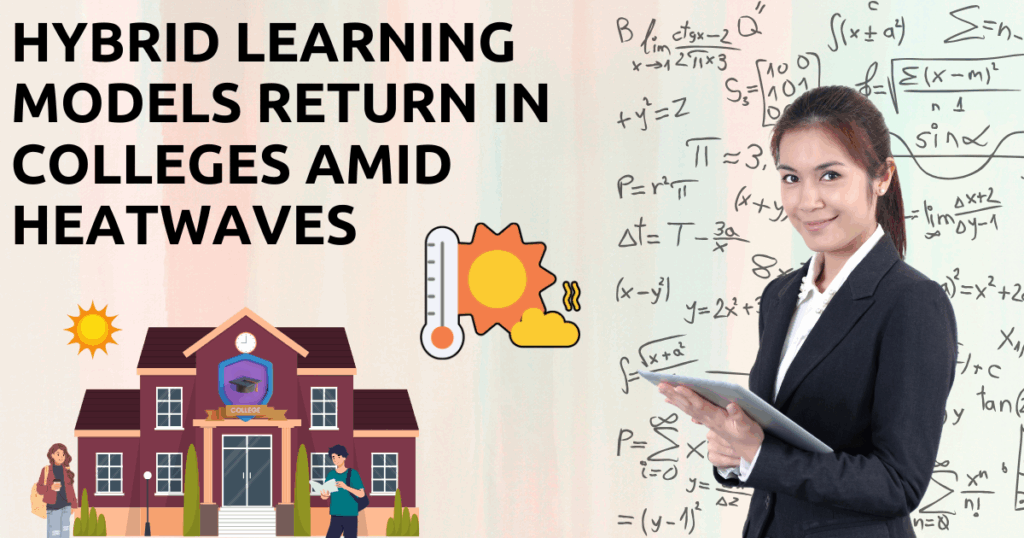Hybrid Learning Models Return in Colleges Amid Heatwaves. The hybrid learning model came to light during the pandemic when students were not able to attend regular classes in their schools or universities. At that time, classes were held online via mobile phones, tablets, laptops, and personal computers. This made the world move forward in digital literacy. Currently, the hybrid mode has made a comeback due to the excessive heat waves that are very harmful for living beings, especially students. To know more about the topic “Hybrid Learning Models Return in Colleges Amid Heatwaves,” read the complete article.
Hybrid Learning Models Return in Colleges Amid Heatwaves
Heatwaves pose a huge threat to environmental sustainability and public health, especially in vulnerable regions and rapidly growing cities. Countries like India face harsh heatwaves which makes transportation and education of children very difficult. This situation has forced schools and colleges to work with hybrid learning models. The pandemic has brought many new challenges for educators as learning in many schools and colleges has changed from in-person instruction to distance learning models that include a combination of in-person instruction and virtual learning.

Hybrid learning refers to an approach in which a group of students participates online while others are taught on campus. This means that the instructor is teaching both remote and in-person students at the same time. Hybrid and remote learning have unlocked opportunities to reach learners who were previously underserved due to geographical, financial, or social constraints. This mode is now used to escape heatwaves and continue the education of students.
Benefits of Hybrid Learning Models
Flexibility
The biggest advantage of hybrid learning models is that they provide flexible hours, unlike in-person learning, where you have to attend classes at a particular time. Students are provided the freedom to arrange their online coursework around their work schedules or other commitments.
Escaping Heatwaves
The heatwaves are a huge cause for students’ absenteeism. Heatwaves can also cause illness to students. To escape from this, colleges provide the hybrid learning module so students can get both virtual and in-person education. Students are allowed to come to college and ask their doubts if they can’t understand it during the online classroom.
Personalized Learning
Hybrid education caters to many different learning styles. Online components are great for students with busy schedules or those who benefit from revisiting material before moving on in the learning process. At the same time, in-person classes provide opportunities for personalized instruction and clarification from teachers. This blend allows students to learn in a way that best suits their individual needs.
Improved Engagement
The range of learning methods provided by blended learning can make the process more engaging and prevent boredom. Online activities like simulations or interactive quizzes can be a welcome part of remote learning that keeps students interested. On the other hand, in-person interaction with classmates and teachers can provide a sense of community and purpose, fostering motivation and a desire to participate actively.
Challenges of Hybrid Learning Models
Exhaustion
Students are exhausted by taking classes sitting at just one place. Most students find online and live classes boring as there is no proper environment to study. The rest breaks are also small and at the end, students are exhausted.
Tech Troubles
Hybrid learning model mostly relies on the internet and the device by which you are taking class. There are always possibilities of tech troubles like bad internet connection, low volume, teacher not audible, smartphone or laptop not working properly, other disturbances, etc.
Time Management
It can be difficult to manage your time effectively between in-person classes, online coursework, and personal commitments. Students are not that good at time management and mostly waste their time, even during the online classes.
Lack of Technical Knowledge
This is a significant challenge in the hybrid learning model. The teachers are not well-educated about the new technology. They face many challenges in content creation and organization for operating online classrooms or working with an LMS portal and troubleshooting the problems that might pop up during sessions.
Although the model allows students to learn at their own pace, it can be difficult for students who struggle with time management, prioritization, or other essential organizational skills. The hybrid learning model might also have a detrimental impact on the virtual students mentally when they see their peers interacting in class while they themselves are tuning in from the isolation of their rooms.

Mark Delyn focuses on education, learning methods, and academic trends. Her work supports students, educators, and lifelong learners with practical and timely insights.







